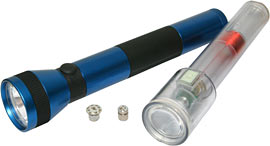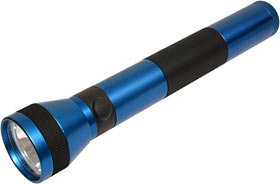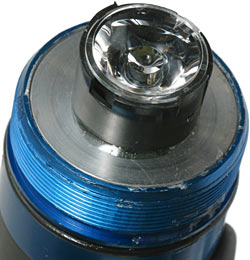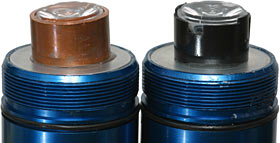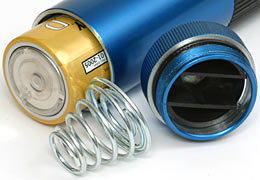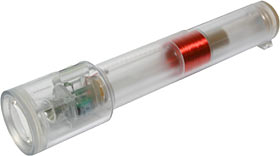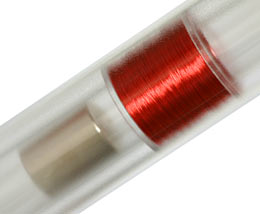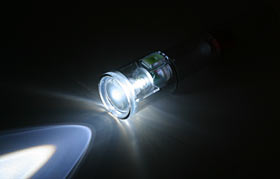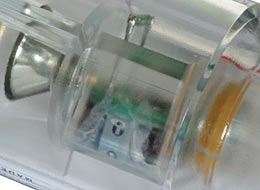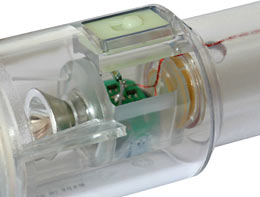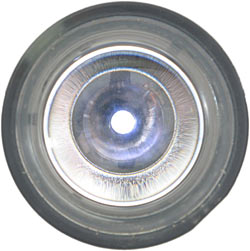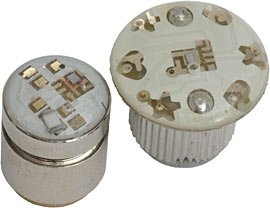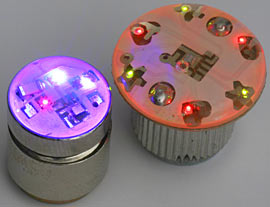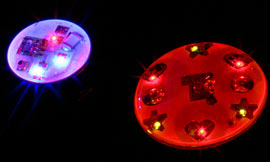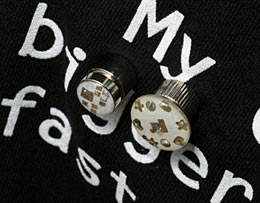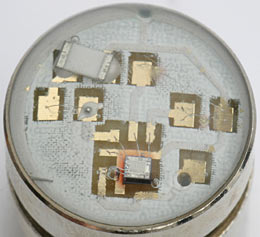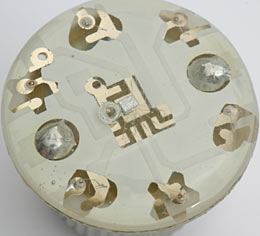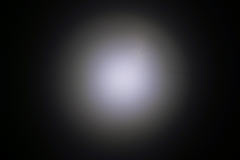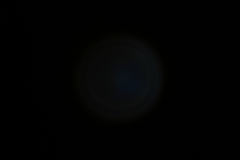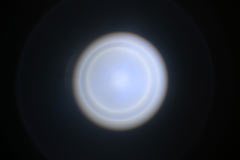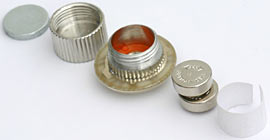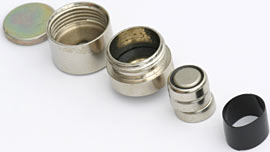
LED light roundup #11
(Elektro Lumens StarLux, ShakeLight NightStar II, and PsychoLights Psycho-Strobe and Psycho-Spinner.)
Review date: 7 October 2002.Last modified 03-Dec-2011.
LED lighting products come in all shapes and sizes.
Case in point.
Two of these things look like flashlights. OK, one of them's got something weird where the batteries should be, but we'll get to that in a moment. It's still flashlight-shaped.
The other two things are little twinkly nuggets of happy pointlessness.
I'll get to them in a moment. First, the most normal of this bunch.
Elektro Lumens StarLux
Elektro Lumens started out as one guy fiddling with incandescent flashlights, retrofitting them with high brightness LEDs.
There's nothing wrong with the retrofit idea - especially now that Lumileds' Luxeon Star LEDs have made it possible to make a bright LED flashlight without using an inelegant and expensive honeycomb array of little LEDs.
I checked out a couple of Elektro Lumens' retrofitted Mag-Lites here; they're fine.
Here's a more advanced Elektro Lumens product, the StarLux. It's still a retrofit, kinda, but it's neat and tidy and works well.
At a glance, the StarLux is an ordinary three-D-cell Mag-Lite clone. Anodised aluminium body with screw-on reflector head and battery-access tail cap, rubber sealed pushbutton power switch. There's a ribbed rubber hand grip and another ribbed ring on the head, and the profile's a bit different from a Mag-Lite, but that's obviously what it's pretending to be.
As Mag clones go, this is a good one. The fit and finish are perfectly acceptable, the threads neither jam nor rattle, and there are waterproofing O-ring seals lubricated with a generous amount of grease.
A genuine three-D-cell Mag-Lite is a sub-$US25 item from non-rip-off stores; if the StarLux had an incandescent globe, then $US20 for it, batteries included, would be fair.
The list price for the StarLux, though, is $US59.99. And it's a good deal.
You can't buy a StarLux right now, as I write this; Elektro Lumens are in the process of switching to an upgraded version, made from stronger aluminium with harder anodising (in basic black), and with a tougher switch, too.
Elektro Lumens have also almost gotten their LED-from-the-ground-up
Blaster II
light to market; it should be shipping shortly, as I write this, and I hope
to scam acquire one for review.
Electrically, the StarLux is much the same thing as the Blaster II. Same lamp, same three-D-cell power.
The StarLux lamp is a one watt white Luxeon Star/O LED, the same as Elektro Lumens used in their modified Mag-Lite. The "O" in the Star/O's name indicates the optics built on top of it; there's a concentrator lens that gives a tighter beam than an unadorned Luxeon Star manages.
The Star/O has about the same beam width as a regular 51mm halogen downlight - not a pencil beam by any standards, but narrow enough to be useful for many flashlight tasks.
I got a couple of StarLuxes (StarLuxi?) for review; one has the normal plastic Star/O housing, and the other one has a slightly lopsided piece of copper pipe. The pipe-mounted Star/O's off-centre aim actually isn't particularly noticeable when you're using it; roll it along a table and you can see the beam wobbling, but it's not wonky enough to be obvious when you hand-hold the light.
Both of these StarLuxes have standard Star/O optics, as did the original Blaster IIs. Elektro Lumens have now moved on to a different and rather larger 30mm collimating lens assembly, which apparently gives a considerably narrower beam, with less light wasted. I hope to check out the new optics soon, on a StarLux or Blaster II.
'Allo 'allo - is that a space for a spare bulb I see in the tail cap? Yes, it is, and it betrays the "factory-retrofit" nature of this flashlight. But it doesn't do any harm. I've seen one retrofitted light (the not-very-good headlamp I review here) which not only had a space for a spare bulb, but actually still had a spare bulb there, despite the fact that the retrofit made it impossible for you to install the bulb. The StarLux is a much better made product than that.
The head of the StarLux turns (easily, even if it's wet, thanks to the rubber grip ring on it), but there's no point turning it, because the Star/O isn't a normal flashlight bulb, and makes close to no use of the flashlight's reflector. The standard medium-wide-angle beam width is what you're stuck with.
Apart from that, though, the StarLux is an entirely professional product. Good looking, solidly made, highly functional, and with all of the benefits of white LED light that people who've read my LED flashlight reviews before will by now be tiring of hearing.
White LED light is much whiter - much less yellow - than light from a normal incandescent flashlight, which makes it more useful per watt. Also, you don't get the annoying uneven rings of light that regular flashlight beams display. And even when the batteries are very close to totally dead, you'll still get a glimmer of white light from the LED; incandescent flashlights get redder and redder as their batteries discharge, and thus force you to change batteries more often.
The StarLux also ought to do a decent job in the secondary Mag-Lite role - the one that gives persons who find themselves in an altercation a stronger connection with antiquity. The LED lamp also means that it shouldn't matter as much if someone forgets that the big end of the flashlight is for illuminating the perpetrator, and the little end is for subduing him.
I'm not, you may be surprised to learn, in the habit of beating the poo out of people. But, speaking as one who at one point used a six-cell Mag-Lite to whack the end of a tyre iron in the process of removing some recalcitrant wheel nuts (in, need I even mention, the rain), and in the process broke the filament of not only the flashlight's in-use bulb but also the foam-cushioned spare in the tailcap, I think there's something to be said for bash-capable flashlights without filament bulbs.
And now: Weirdness.
The NightStar II
The NightStar II is light, toy and electromagnetism demonstration, all in one.
It's also unquestionably the worst flashlight I've ever seen, if all you're interested in is size versus brightness. The "NightStar II" is, apparently, smaller and brighter than the original NightStar, but it's still the size of a D-cell flashlight, and its single 5mm LED is driven quite gently. It produces a wan circle of light which you'll only barely be able to see on the wall of a normally lit room, at a distance of two to three metres. It's certainly not so dim as to be useless, but it's way, way dimmer than the StarLux.
The NightStar II is about 255mm (10 inches) long, and weighs about 314 grams (11 ounces). The StarLux is about 292mm long (11.5 inches), and weighs about 343 grams (12 ounces) without batteries, or around 780g (27.5 ounces) with three ordinary alkaline D cells.
The NightStar, however, doesn't need batteries. It runs its lamp from a capacitor, which you charge by shaking the light.
The capacitor is a one Farad 5.5 volt double layer electrolytic "supercap", as seen providing backup power to volatile memory in various electronic devices. It should be good for hundreds of thousands of full charge/discharge cycles. And the lightly loaded LED ought to have a solid hundred thousand hour life before it dims to even 80% of its original brightness. And the body of the NightStar's made from super-tough polycarbonate (the ShakeLight people are happy to demonstrate just how tough), and sealed tight, with a 180 foot dive rating. It floats, too, lamp-upwards (the original NightStar didn't).
What all this means is that the NightStar II is as close to immortal as any flashlight has ever been.
There are lots of lights out there that're built like tanks, but if the batteries are flat, they're paperweights. The NightStar II will last pretty much as long as there are humans to shake it.
OK, the lens on the end may get hopelessly scratched eventually (there's a raised lip to protect it from damage, but the lens is only plastic), and I suppose the charge magnet inside (of which more in a moment) might eventually wear a hole in the internal tube it slides in. But if you're looking for a working definition of the term "built to last", this thing is it.
ShakeLight sell the NightStar II for $US39 plus shipping.
Here's the NightStar's dynamo. An inch-long cylindrical rare earth magnet (the same neodymium-iron-boron type as the ones I ramble on about here) slides freely through the middle of a tight coil of enamelled wire. Faraday's Law takes care of the rest.
To stop the magnet from slapping the ends of its tube as you shake the light, there's a smaller rare earth disc magnet at each end of the tube. These magnets repel the big one strongly enough that it hovers around three centimetres from the end of the tube, when the flashlight's standing on end. That's what it's doing in the above picture, by the way.
You can't really see it in the picture, but the sliding magnet also has a little clear rubber foot stuck on each end of it. So even if you shake the flashlight with such enthusiasm that the sliding magnet could slap one of the end magnets, it'll actually just bounce off.
All of these magnets, of course, mean that the NightStar has a substantial external magnetic field. It's not instant death to any floppy disk or credit card you walk past, but it'll noticeably distort the image on a CRT screen from about a foot away. It also likes to collect small ferromagnetic objects that it touches; it can store a quite large number of paper clips.
The tail repulsion magnet is strong enough that the NightStar will hang lens down, somewhat precariously, from an iron or steel surface. The end of the flashlight isn't actually quite a flat disc; it's got a slight ridge in the middle, perhaps for strength. You can still stand it on its end, though, for bounce-light from a ceiling.
Since it's clear, the NightStar also provides some all-around light if it's standing lamp-down on a surface. In that mode, it's a pretty good nightlight - as it turns out, the length of time it'll glow for on one charge ought to quite neatly match the length of time it takes someone to go to sleep.
The printing stamped on the opposite side of the NightStar's head from its switch says "90 short fast shakes to recharge", but that refers to a full charge, not just enough to get light. The NightStar II gives you reasonable brightness on the first or second shake; you're not sitting there making like a mariachi percussionist for 30 seconds before you can see what's going on.
You also don't have to turn the NightStar II off to charge it, so you can idly shake it while you're walking around.
After a full charge, the NightStar II's output was noticeably dimmed after five minutes, but was still better than useless after another five minutes.
Looking in through the side of the NightStar, you can see the capacitor hanging off the bottom of the little circuit board.
The circuit board doesn't have a big component count. It deals with the alternating current from the coil (the polarity reverses with the movement of the magnet), and I think it also provides some regulation, to give the LED as constant a supply voltage as possible from the capacitor, whose terminal voltage varies with its charge level. The NightStar dims as it discharges, and flickers more brightly than its full charge brightness if you shake it while it's turned on.
The "goalpost" thing on top of the circuit board...
...which is more visible in this picture, is a reed switch. Reed switches close in the presence of a magnetic field, and the slide switch on the outside of the lamp has another magnet attached to it, which closes the reed switch when you move the slider forward. This design means that the power switch doesn't need a hole in the NightStar's casing, which accounts for the flashlight's excellent waterproofing. Normal slide switches are very difficult to waterproof, which is why many cheaper dive lights have twist-the-end switch mechanisms.
The slide switch, by the way, glows in the dark.
The NightStar II's lamp is an unremarkable 5mm white LED, mounted in the middle of a small conical reflector that does a lot less for the light's output brightness than does the lens on the end of the lamp assembly. The electronics module is held inside the end of the flashlight by three sturdy stiffening ribs on one side, and by the solidly glued front repulsion magnet on the other side; it ain't going anywhere.
And now, foolishness.
Psycho-things
PsychoLights sell a range of entertaining little key-ring lights that I checked out a couple of comparisons ago. They also, however, sell these.
On the left, a "Psycho-Strobe", with three tiny LEDs under its clear plastic top-dome. This one has two blue LEDs and one red one; there's a two-LED blue and yellow model, as well. On the right, a "Psycho-Spinner", with a bigger top that contains six LEDs, three red and three green.
Turn them on by tightening down their threaded tops, and they flash their LEDs in sequence. the Strobe creates a twinkly effect, while the Spinner's sequence makes it seem to, well, spin, anticlockwise.
Capturing the effect in a video clip isn't easy. PsychoLights have not-so-great clips on their Strobe pages here and here, and their Spinner page here, but they don't give you a very good idea of what the things look like in use. They're bright and cheerful and twinkly...
...and, in a still photo with a reasonable exposure time, they look like this...
...or like this.
One major selling point for these things is that they're rather cheap. The ex-shipping list price for Strobes and Spinners is $US4 and $US4.50, respectively, or less in quantity; as I write this, PsychoLights are having a clearance sale that makes these lights significantly cheaper again.
Another selling point is that you can stick them to things. The Strobe and Spinner each have a rare earth magnet (they're everywhere!) attached to the bottom of their casing, and come with a second loose magnet that you can use to attach them to non-magnetic things...
...like, for instance, your favourite T-shirt. The loose magnet goes on the far side of the thing you're attaching the light to, and gloms onto the magnet on the light's base.
The magnets are strong enough to hold the Strobe or Spinner firmly on an earlobe, though you have to take care not to lose the loose magnet when you remove the light from your person.
They're small, too. The Psycho-Strobe, without its bottom magnet, is about 13mm high - 0.51 inches - when turned off; the screw-down switch mechanism makes it a little shorter when it's on. It's about 10.9mm wide (0.43 inches). It weighs about 5.5 grams (a bit less than a fifth of an ounce), with its extra magnet.
The Spinner, turned off and without its loose magnet, is the same height as the Strobe, but only 11mm wide (0.43 inches) at the body; the top piece is 16.1mm wide (0.63 inches). It weighs about six grams (a bit more than a fifth of an ounce), with its extra magnet.
In extreme close-up, you can see the little square LED dies hanging on their wires between the solder pads on the surface of the Psycho-Strobe, and you can also see that the quality control for these things isn't exactly up to Swiss watch standards. There are lopsided components, and bubbles and other inclusions in the top plastic. PsychoLights apparently weed out a fair few duds from the lights they receive from the manufacturer; other dealers who sell these things may or may not be as careful.
Despite its imperfections, though, this is an interesting looking little widget. If you'd like a 1500 pixel wide version of the above image, for desktop wallpaper or mere ogling purposes, you can find it here.
The Psycho-Spinner looks similarly dodgy in extreme close-up. This one's got a big bubble in the middle.
Hey, it's a feature, not a bug; the bubble twinkles along with the LEDs when the Spinner's turned on.
There's a 1600 pixel wide version of the above picture here.
Power and output
The StarLux's lamp only has a one watt rating (you can get more out of a "one watt" Luxeon Star, but only with unusually good cooling), but it delivers high colour temperature white LED light, not wan yellow incandescent-bulb light.
Luxeon Stars, like other white LEDs, are not all exactly the same; of the two StarLuxes I got to play with, one has a classic blue-ish beam that's a bit bluer than overcast daylight, while the other is noticeably greener. These differences are caused by oddities in the phosphor coating over the actual LED die, which outputs only blue light; the phosphor on different LEDs generates different amounts of the other colours, and lets through different amounts of the underlying blue. Any regular-grade white LED, though, has notably superior colour rendering, for most purposes, than regular incandescent bulbs. Things look better by LED light.
This is an f3.5, 1/30th second, ISO 100 exposure (photographic mumbo-jumbo explanation here) of the greener StarLux's beam on a piece of white foam-board, which is half a metre tall and about a metre from the camera. The central hot spot is illuminated about six times as brightly as it is when the (small) room's 50cm fluorescent light is turned on; that fluoro is all the room needs to be perfectly adequately lit. This is not a dim flashlight.
A three-D-cell flashlight with the same kind of bulb that Mag-Lite provide with theirs would, set to the same beam width, light up the target even more brightly, as far as a lightmeter was concerned. The human eye's better response to bluer light, though, and the nice smooth light-pool from the LED lamp, mean that the StarLux does not actually appear much dimmer.
A regular Mag-type flashlight also, however, gives you a focusable beam; the StarLux doesn't. If you need narrow beam lighting, most LED flashlights still don't provide it. Most of the time, though, many flashlight users want a quite wide beam; they want to see where they're going, not what's at the top of a tree. For that, the StarLux is very good indeed.
Now, for comparison, here's the beam from the NightStar II, shot at the same exposure settings.
It's barely visible.
It takes a 0.7 second exposure, 21 times as long, to make it look like this.
Now you can see the mildly uneven light distribution created by the relatively distant, relatively large focusing lens. The NightStar II beam is still very even by incandescent flashlight standards, though; it's just not terribly bright.
The non-removable lamp of the StarLux makes it a bit annoying to get really accurate power figures for it, but just sticking my multimeter in place of its tail cap revealed that, after a little warm-up time, it drew 900mA from its batteries. That's through the meter and its leads, which contribute 0.3 ohms of resistance of their own; in most situations that's not enough to make a significant difference, but for (relatively) low voltage, high current applications like this, it does. Still, it gives a decent idea - something like an amp.
Energizer's data sheets for their regular and "E2" alkaline D cells (which you can find in PDF format here and here, respectively) show that with these cells you can expect around eight and seven hours of service, respectively, at one amp, if your cutoff voltage is 0.8V.
You'll get a lot more battery life than that out of a StarLux, though, because its load will decrease as the batteries go flat, and also because the Luxeon Star, like all LEDs, will still produce useful light when the batteries are much too weak to do anything worthwhile with an incandescent bulb.
I don't, by the way, have particular love for Energizer over all other battery companies; the PDF datasheets for Duracell's matching products are here and here. They tell much the same story.
Both of the little Psycho-Whatsits have the same basic construction. Their cases screw together; inside there's a stack of tiny watch batteries, surrounded by an insulating sleeve (paper for the Psycho-Spinner, shown above; plastic for the Psycho-Strobe).
The Spinner runs from a pair of AG3 button cells, also known as LR41s, among various other names; PsychoLights sell them for $US1.50 for ten. These cells have a capacity of around 40 milliamp-hours (mAh). That's into a really tiny load, though; these cells can power a watch for a year or three, but aren't meant for this sort of application.
From fresh AG3s, the Spinner drew about 10 milliamps (mA), though my multimeter; it'd draw a little more without the multimeter in the circuit. At that load level, the little AG3s will scream for mercy, and won't deliver anything like the four hours of service you'd expect from their rated capacity. But, fortunately, they won't have to; as they flatten, their reduced terminal voltage will cause the current draw to fall.
From only one cell, the Spinner still just barely runs - the three red LEDs dimly glimmer in order, but there isn't enough voltage to light the green ones. In this thoroughly unexciting mode, the Spinner draws less than a tenth of a milliamp.
The Psycho-Strobe's put together in the same way as the Psycho-Spinner, except it's powered by three AG4 (or SR626SW, or 377...) cells, which're rated at around 30mAh. It drew around 8mA out of three fresh cells, though my multimeter, which means it'll beat its batteries to death faster than the Spinner will. Both of these little lights, though, should last for the duration of the average party, or at least until you no longer care whether your lapel is still twinkly.
Changing the batteries in these tiny lights is, unavoidably, fiddly, but it's not terribly hard. It helps to have a small prodding object to hand to deal with the first cell, which will want to hop in sideways and stick to the magnet at the bottom of the battery compartment.
Overall
The StarLux is a perfectly good piece of gear; the better collimating optics in the upcoming Blaster II should make it, for the same money, an even better one.
Sixty US bucks is a lot of money if you're someone who's used to buying flashlights from the supermarket, and super-high-intensity LED technology will certainly percolate down into the regular consumer market. In a few years, you'll probably be able to buy a flashlight with the output of a StarLux for ten bucks.
That cheap flashlight probably won't be made as well as the Elektro Lumens lights, though. These things are solid, as well as bright. If not lost or stolen, you can reasonably expect one of these lights to last you a lifetime, with normal domestic use.
The same applies to the NightStar II. It's not in the same league as a one watt light like the StarLux; this thing is strictly a seeing-where-your-feet-are-going sort of light, and it helps a lot if your eyes are accustomed to darkness.
But - no batteries!
Ever!
As a bedside table light, the NightStar II is great. When you're padding from your bedroom to your bathroom/kitchen/dungeon, you don't want a really bright flashlight messing up your night vision, and a good-sized light with a glow in the dark switch is easier to find on the bedside table. A little light you can hold in your mouth while you stealthily assemble a midnight snack would be nice, too, but you can't have everything.
I wouldn't go so far to say that every home should have a NightStar II, but it is one of the neatest gadgets I've laid my hands on. Flashlight, nightlight, fiddle-toy, educational device, geek mantelpiece ornament. And it costs only $US39 plus shipping, which isn't stupidly expensive for what you get.
The little Psycho-Thingies are a lot of fun. They could be slightly useful, if you need a tiny marker light with a few hours of run time that you can stick to a car or model boat or whatever, but they're built for pure frivolity, and they suit the purpose well. And they're cheap! What's not to like?
StarLuxes kindly provided by Elektro Lumens
NightStar II kindly provided by ShakeLight
Psycho-Spinner and Psycho-Strobes kindly provided by PsychoLights
